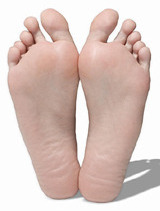The word bunion comes from the Latin “bunio” which means enlargement. A bunion is an enlargement of the joint at the base of the big toe – the metatarsophalangeal (MTP) joint. It forms when the tissue or bone at the big toe joint moves out of place forcing the toe to bend towards the others causing a painful lump of bone on the foot.
 Symptoms of bunions include the development of a bump on the outside of the foot at the base of the big toe, redness, swelling and pain of the MTP joint, painful motion of the big toe and the development of corns caused by the overlap of the first and second toes.
Symptoms of bunions include the development of a bump on the outside of the foot at the base of the big toe, redness, swelling and pain of the MTP joint, painful motion of the big toe and the development of corns caused by the overlap of the first and second toes.
The MTP joint flexes with every step we take so bunions can cause extreme pain when walking and wearing shoes. An advanced bunion can make a foot look grotesque and can even lead to arthritis.
Bunions form after years of abnormal motion and pressure on the MTP joint usually caused by the way we walk, inherited foot type or ill-fitted shoes.
Most bunions can be treated without surgery. The main focus in early treatment is to relieve the pressure on the bunion to stop the progression of the joint deformity. Applying bunion pads around the bone, wearing shoes with wide toe boxes and avoiding high-heeled shoes can relieve pressure. Inflamed bunions can be treated with ultrasound therapy, ice and anti-inflammatory drugs. If surgery is required the bony enlargement will need to be removed to restore the normal alignment of the toe joint and relieve pain. Recuperation after surgery can take time and may include persistent stiffness and swelling.
Contact Us to arrange an appointment or consultation today!
